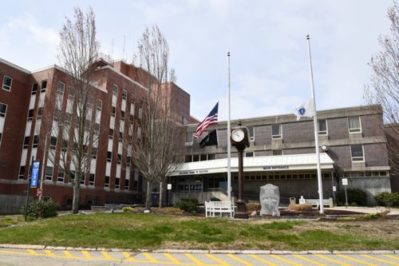Facilities Have Seen Large COVID-19 Outbreaks

The Holyoke Soldiers’ Home in Holyoke, MA, shown here, was the site of a devastating COVID-19 outbreak.
DoD photo by Air Force Master Sgt. Lindsey Watson-Kirwin, Massachusetts Air National Guard
WASHINGTON — What responsibility does VA have for state veterans homes and the tsunami of COVID-19 infections and deaths that have swept through facilities nationwide? While these homes are not operated by VA, the department does pay for veterans being housed there and regularly inspects them.
Some legislators and overseers have argued that the department’s loose oversight allowed for weak infection control practices and contributed to the deaths of thousands of nursing home residents during the ast six months.
State veterans homes are the largest provider of nursing home care for veterans in the country, accounting for about half of veterans who receive VA-funded nursing home care. VA’s community living centers (CLCs) provide for 25%, with the rest being made up by VA purchasing care in other community homes.
As the pandemic has swept the nation, nursing homes have accounted for a disturbing percentage of infections and deaths. A report in June found that approximately 50,000 residents of long-term care facilities had died from COVID-19, making up 40% of pandemic-related deaths in the United States at that time. The percentage of those made up by residents of state veterans homes is unknown, as reporting requirements vary.
State veterans homes account for some of the most egregious infection cases that have garnered national attention, however, not just due to the number of deaths but also because of the mismanagement of their infection control procedures.
The Holyoke, MA, Soldiers Home eventually had 57% of residents test positive, along with 81 staff members. By July, 76 patients had died. Subsequent investigations by state authorities found delays in testing, staffing shortages, and a failure to stop rotation of staff among units contributed to the rapid spread.
By June, New Jersey Veterans Home in Paramus had recorded 81 patient deaths and 93 infected employees, including one employee death. Employees reported that they were initially told not to wear masks or gowns because it could scare the residents.
The Southeastern Veterans Center near Philadelphia initially went without screening, PPE or any plan to identify sick residents and track their contacts. Consequently, infected patients were placed back with healthy ones. That home recorded 42 deaths.
The facility also spent two weeks administering hydroxychloroquine, the malaria drug that was initially thought to provide some benefit against COVID-19, to infected and uninfected patients. While the Food and Drug Administration had allowed emergency use of the drug for COVID-19 to hospital settings, that action has since been revoked.
Health officials said they were not surprised that nursing homes have been hit hard during the pandemic. The virus has been particularly deadly for older adults, who are more likely to have comorbid conditions and less likely to survive the more extreme measures to save their lives.
Continue Reading this Article: CLCs Fared Well

